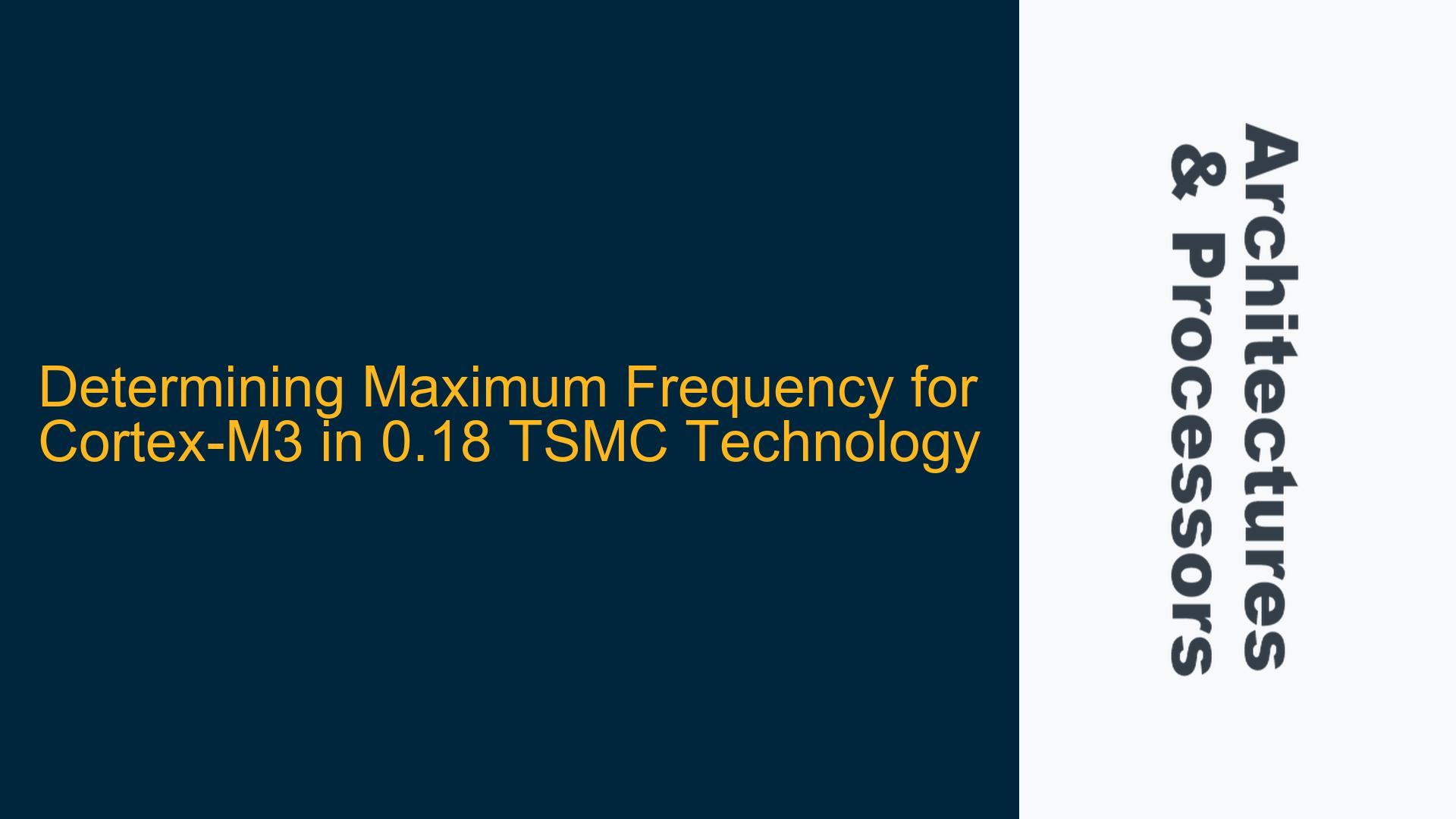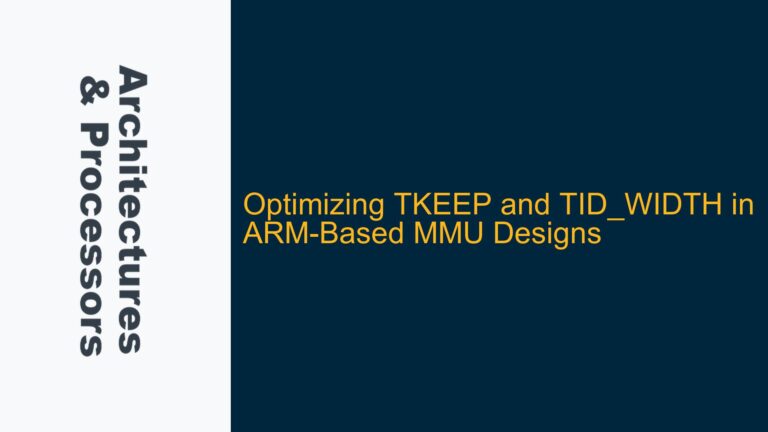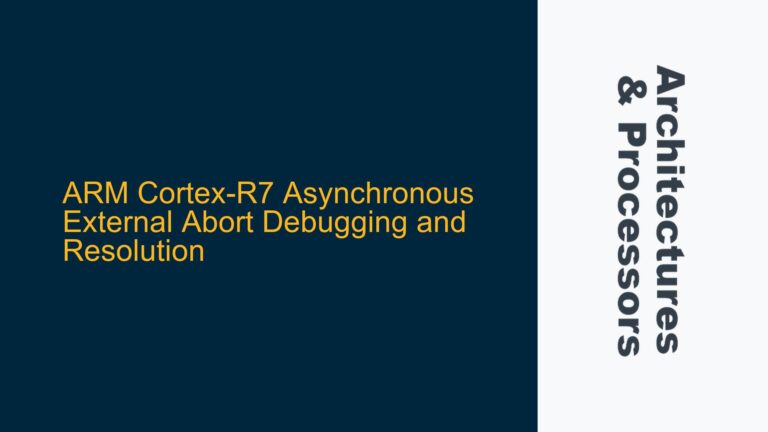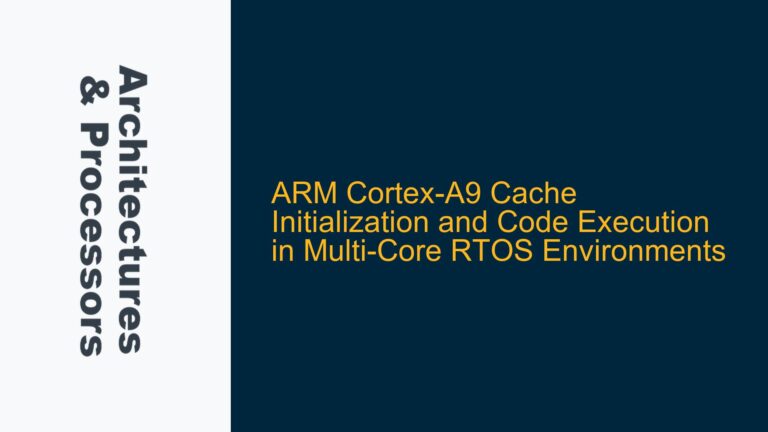Cortex-M3 Frequency Limitations in 0.18 TSMC Process Nodes
The Cortex-M3 processor, a widely used ARM core in embedded systems, is known for its balance of performance, power efficiency, and cost-effectiveness. However, determining its maximum operating frequency in a specific process node, such as TSMC’s 0.18µm technology, involves a complex interplay of factors. These factors include the specific variant of the 0.18µm process (e.g., 180G, 180ULP, 180ULL), the configuration of the Cortex-M3 core, and the implementation choices made during the physical design phase. The maximum frequency is not a fixed value but rather a result of the synthesis, place-and-route, and timing closure processes, which are influenced by the target library, design constraints, and the expertise of the engineering team.
The Cortex-M3 core is designed to be highly configurable, allowing for optimizations tailored to specific applications. Key configuration options include the number of interrupt requests (IRQs), the width of the interrupt priority field, the presence of optional features like the Memory Protection Unit (MPU) and Embedded Trace Macrocell (ETM), and the use of bit-banding for atomic bit manipulation. Each of these options impacts the overall area, power consumption, and achievable frequency. For instance, enabling the MPU and ETM increases the gate count and routing complexity, which can reduce the maximum frequency due to increased signal propagation delays.
In the context of TSMC’s 0.18µm process, the achievable frequency is further influenced by the specific process variant. The 180G (General Purpose) variant is optimized for a balance of performance and power efficiency, while the 180ULP (Ultra-Low Power) and 180ULL (Ultra-Low Leakage) variants prioritize power savings over maximum frequency. The choice of process variant directly affects the transistor characteristics, such as threshold voltage and leakage current, which in turn impact the timing margins and the maximum frequency.
Factors Influencing Cortex-M3 Frequency in 0.18 TSMC Technology
The maximum frequency of the Cortex-M3 core in a 0.18µm TSMC process is influenced by several interrelated factors, including the process variant, the core configuration, and the physical implementation. Understanding these factors is crucial for setting realistic performance expectations and making informed design decisions.
Process Variant Characteristics
TSMC’s 0.18µm process family includes multiple variants, each optimized for different design goals. The 180G variant is designed for general-purpose applications, offering a balance of performance and power efficiency. It typically achieves higher frequencies compared to the 180ULP and 180ULL variants, which are optimized for ultra-low power and ultra-low leakage, respectively. The 180ULP variant sacrifices some performance to minimize dynamic power consumption, making it suitable for battery-powered devices. The 180ULL variant further reduces leakage current, which is critical for applications requiring long standby times.
The choice of process variant affects the transistor’s electrical characteristics, such as threshold voltage (Vt) and on-current (Ion). Higher threshold voltages in the 180ULP and 180ULL variants reduce leakage but also decrease the transistor’s switching speed, limiting the maximum frequency. Conversely, the 180G variant uses lower threshold voltages, enabling faster switching at the cost of higher leakage current.
Core Configuration and Feature Set
The Cortex-M3 core’s configurability allows designers to tailor the processor to their specific needs, but each configuration choice has implications for performance. For example, increasing the number of IRQs or the width of the interrupt priority field adds complexity to the interrupt controller, which can introduce additional timing paths and reduce the maximum frequency. Similarly, enabling optional features like the MPU, ETM, and bit-banding increases the gate count and routing complexity, potentially impacting timing closure.
The presence of the MPU, which provides memory protection capabilities, adds logic for address decoding and permission checking. This logic introduces additional delays in the memory access path, which can limit the maximum frequency. The ETM, used for real-time trace and debugging, adds significant complexity to the design, particularly in the routing of trace signals. Bit-banding, which allows atomic bit manipulation in specific memory regions, requires additional logic for address translation and data masking, further impacting timing.
Physical Implementation and Design Constraints
The physical implementation of the Cortex-M3 core, including synthesis, place-and-route, and timing closure, plays a critical role in determining the maximum frequency. The synthesis process translates the RTL (Register Transfer Level) description of the core into a gate-level netlist, optimizing for area, power, and timing. The choice of synthesis constraints, such as target frequency and clock uncertainty, directly impacts the achievable performance.
During place-and-route, the gate-level netlist is mapped to the physical layout of the chip. The placement of cells and routing of signals must meet timing requirements while minimizing congestion and power consumption. In the 0.18µm process, the relatively large feature size compared to more advanced nodes (e.g., 28nm) results in longer interconnect delays, which can become a limiting factor for high-frequency operation.
Timing closure is the process of ensuring that all timing paths in the design meet the required constraints. This involves iterative optimization of the netlist and layout to resolve timing violations. In the 0.18µm process, achieving timing closure at high frequencies can be challenging due to the slower transistor speeds and longer interconnect delays. Designers must carefully balance the trade-offs between frequency, area, and power to achieve a viable implementation.
Strategies for Maximizing Cortex-M3 Frequency in 0.18 TSMC Technology
Achieving the maximum frequency for the Cortex-M3 core in a 0.18µm TSMC process requires a combination of careful configuration, optimized physical implementation, and thorough timing analysis. The following strategies can help designers push the performance limits while meeting area and power constraints.
Optimizing Core Configuration
To maximize frequency, designers should carefully select the Cortex-M3 core configuration options. Disabling unused features, such as the MPU and ETM, reduces the gate count and simplifies the design, improving timing margins. Similarly, minimizing the number of IRQs and the width of the interrupt priority field reduces the complexity of the interrupt controller, which can help achieve higher frequencies.
Bit-banding, while useful for certain applications, introduces additional logic that can impact timing. If bit-banding is not required, disabling it can improve performance. Additionally, using the smallest possible data path width (e.g., 32-bit instead of 64-bit) reduces the complexity of arithmetic and logic units, further enhancing timing margins.
Leveraging Process Variant Strengths
Selecting the appropriate process variant is critical for achieving the desired balance of performance and power efficiency. For applications requiring maximum frequency, the 180G variant is the best choice due to its lower threshold voltage and faster transistor speeds. However, designers must be mindful of the increased leakage current and power consumption associated with this variant.
For ultra-low-power applications, the 180ULP and 180ULL variants are more suitable, but they come with a trade-off in maximum frequency. In such cases, designers can explore techniques such as voltage scaling and clock gating to optimize power consumption while maintaining acceptable performance levels.
Advanced Physical Implementation Techniques
To achieve high frequencies in the 0.18µm process, designers must employ advanced physical implementation techniques. These include:
-
Timing-Driven Synthesis: Using synthesis tools with timing-driven optimization capabilities ensures that the gate-level netlist is optimized for the target frequency. Setting aggressive timing constraints and enabling high-effort optimization modes can help achieve better results.
-
Clock Tree Synthesis (CTS): A well-optimized clock tree is essential for minimizing clock skew and ensuring reliable operation at high frequencies. Using a balanced clock tree structure and carefully tuning the buffer sizes can improve timing margins.
-
Placement and Routing Optimization: During place-and-route, designers should prioritize timing-critical paths and minimize interconnect delays. Techniques such as cell sizing, buffer insertion, and wire spacing can help reduce signal propagation delays and improve timing closure.
-
Timing Analysis and Iterative Optimization: Thorough timing analysis, including static timing analysis (STA) and sign-off checks, is essential for identifying and resolving timing violations. Iterative optimization, involving multiple passes of synthesis, placement, and routing, may be necessary to achieve timing closure at the desired frequency.
Collaboration with Foundry and ARM Support
Given the complexity of achieving high frequencies in the 0.18µm process, collaboration with the foundry and ARM support teams is highly recommended. Foundries provide detailed process-specific design guidelines and libraries that can help optimize the implementation. ARM offers configuration and implementation support, including access to reference designs and expert advice, which can be invaluable for achieving the best possible performance.
In conclusion, determining the maximum frequency for the Cortex-M3 core in a 0.18µm TSMC process involves a deep understanding of the process characteristics, core configuration options, and physical implementation techniques. By carefully optimizing these factors and leveraging available resources, designers can achieve high-performance implementations tailored to their specific application requirements.






